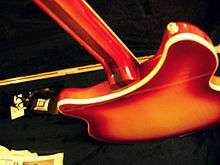Set-in neck
Set-in neck is a method of guitar (or similar stringed instrument) construction that involves joining neck and body with a tightly fitted mortise-and-tenon or dovetail joint, secured with some sort of adhesive. It is a common belief that this yields a stronger body-to-neck connection than a bolt-on neck, though some luthiers believe a well-executed bolt-on neck joint is equally strong and provides similar neck-to-body contact. However, neither of these joints is as strong as a neck-through body construction, which requires more material and is usually only on high-end solid body guitars.

Set-in necks are the most popular on acoustic guitars. Almost all major acoustic guitar manufacturers use set-in necks, with notable exceptions being Taylor Guitars, Godin Guitars, and Collings Guitars. In the electric guitar market, Gibson produces almost all of its electric offerings as set-in neck models—as opposed to Fender, which builds most of its electric instruments with bolt-on necks. In rare cases, makers use other solutions. Babicz Guitars makes a mechanically joined neck that can be "wound" up or down to adjust action height.
Glues
Wooden musical instrument construction relies on four widely used types of glues:
- Hide glue
- PVA ("white glue" and "yellow glue")
- Epoxy and Cyanoacrylate (less common because they make it difficult to disassemble the joint for repair)
Advantages
Typically cited advantages of set-in neck include:
- Warmer tone
- More sustain
- Often, better access to top frets compared bolt-on necks that use a square metal plate
- Because the increased surface area results in more transmission of strings vibration, set in necks can feel more "alive" than if bolted on.
Disadvantages
- Certain models seem prone to neck breakage. Though this may be due to weaker neck wood (mahogany instead of maple), the greater difficulty in replacing a neck that is glued-in vs. one that is bolted on should be apparent.
- Harder and more expensive to mass manufacture than bolt-on necks—harder to repair or service because the glue must be steamed or melted with a hot knife
- The player has no control over the neck-to-body angle; changing it requires disassembling the instrument and re-glueing the neck by an experienced luthier.